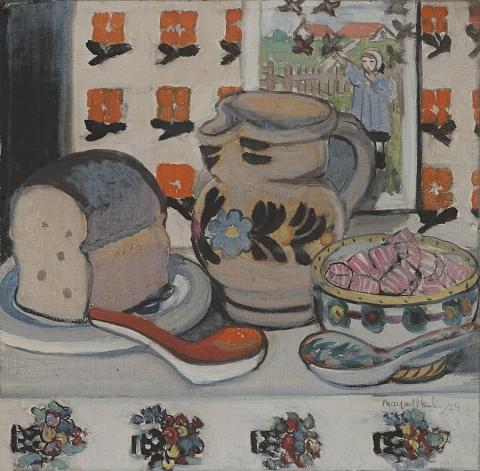FOR A LITTLE GIRL, 1929
MARGARET PRESTON
oil on canvas
30.5 x 30.5 cm
signed and dated lower right: Margaret Preston/29
Leon Gellert, Sydney
Elizabeth Gowland (née Gellert), Sydney, a gift from her father
Thence by descent
Anthony Gowland, Sydney
Thence by descent
Private collection, Sydney
Margaret Preston, Grosvenor Galleries, Sydney, 7–31 August 1929, cat. 34, 10 gns
Margaret Preston Catalogue raissoné of paintings, monotypes and ceramics, Art Gallery of New South Wales, Sydney, 2005, CD-ROM compiled by Denise Mimmocchi, with Deborah Edwards and Rose Peel
For a Little Girl, 1929 brings into the public domain an exciting new work by Margaret Preston, virtually unknown until now. It joins those fabulous paintings of the late twenties such as the wonderfully adventurous Implement Blue, 1927 (Art Gallery of New South Wales, Sydney) and Aboriginal Flowers of 1928 (Art Gallery of South Australia, Adelaide), through to Pink Gum Blossoms, 1929 (private collection). Preston must have thought highly of them for in 1960 she gifted Implement Blue, 1927 to the Art Gallery. It is also significant that many of the paintings from this time are in our leading national, state and regional galleries. For a Little Girl 1929 was among these outstanding works included in Preston's exhibition at Sydney's Grosvenor Galleries, being her first solo show of paintings. It was a sell out, as Deborah Edwards noted, 'widely well reviewed (the Home and Art in Australia had been publicising the show months in advance as 'promising to be historical in the art world of Australia').'1
Leon Gellert was a close associate of Preston's, publishing in 1929, the same year this work was painted, a limited edition of the fully illustrated book, Margaret Preston Recent Paintings. Gellert together with Sydney Ure Smith had been co-editor of Art in Australia since 1922. He was also associated with the stylishly elegant magazine, The Home, and wrote a widely read column for the Sydney Sunday Herald. The Preston 'book', however, was more a portfolio of reproductions of paintings and prints, and a number of her aphorisms. Although For a Little Girl, 1929 was not included, Gellert already had a 1913 Holiday Still Life by Preston, 'in the Impressionist manner'.2 By 1929 she had embraced more adventurous and individual ways, experimenting with form, colour and composition.
In For a Little Girl, 1929, things of everyday life are transformed into visual adventures.The common place loaf of bread, ceramic jug, and bowl of red and white striped boiled sweets become things visually exciting as, flattened, they take on new shapes, allied to colours likewise decorative. Any tendency towards sweetness is banished through the power of expression, abstract ordering, and delight in underlying geometric forms. The interplay between the flatness of the picture plane and the illusion of depth is central to the painting's fascination. While surface flatness allied to the overall decorative quality wins, illusion keeps tantalizing the eye as it steps into the picture - up the edge of the tablecloth, steady tread across its surface, a vertical floral-patterned wall, and then incredibly out-of-doors through the picture of the young girl feeding the birds. While narrative is banned from her painting, Preston illustrates its absence by introducing it into the picture within the picture. The floral patterning of single flowers and full vases has never looked so singular, wondrously changed by the alchemy of Prestons brush.
1. Edwards, D., Margaret Preston, Art Gallery of New South Wales, Sydney, 2005, p. 139
2. Gellert, L.,'Margaret Preston was one of the greats', Sunday Telegraph, Sydney, 8 January 1967, p. 14, quoted in Butel, E., Margaret Preston: The Art of Constant Rearrangement, Viking in association with Art Gallery of New South Wales, Sydney, 1985, p. 15
DAVID THOMAS
